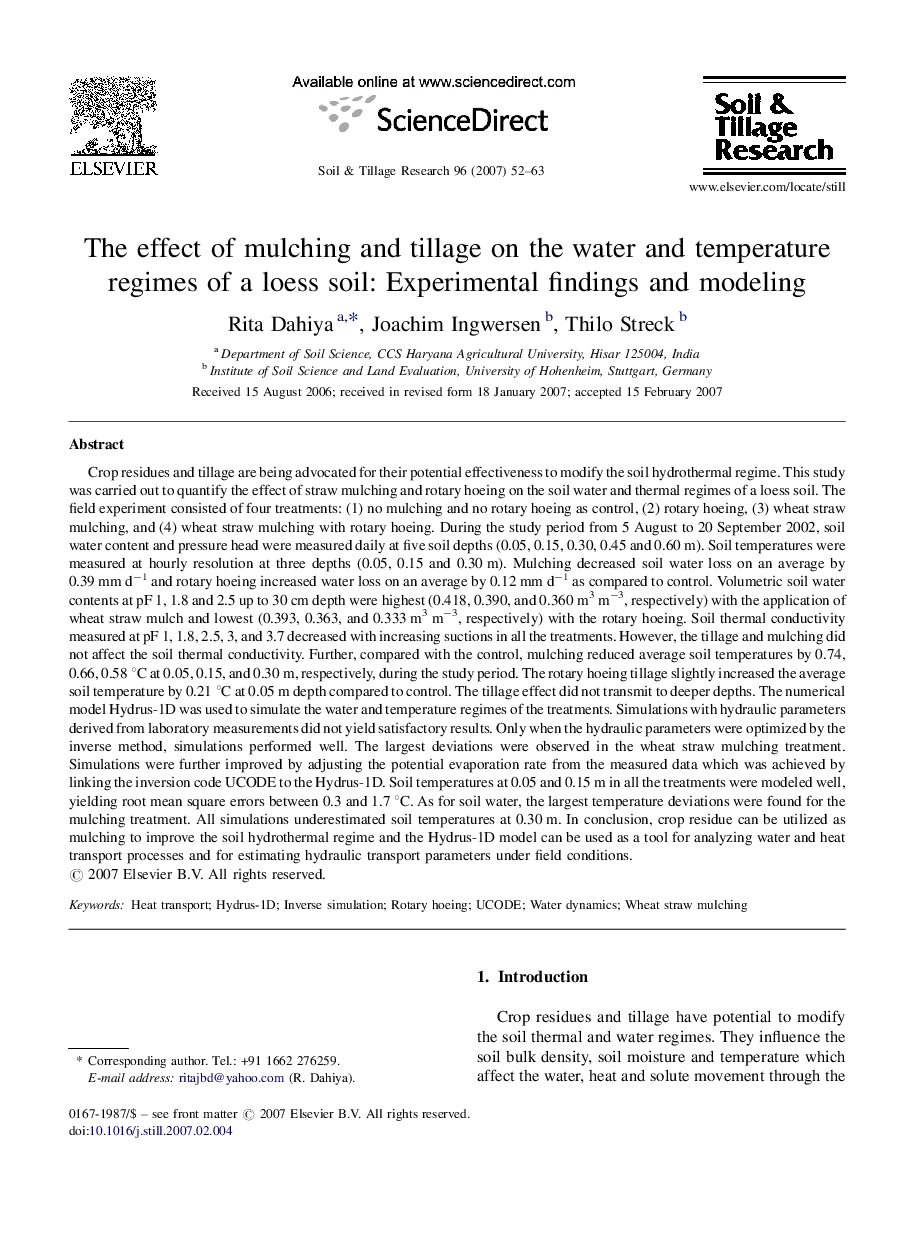| کد مقاله | کد نشریه | سال انتشار | مقاله انگلیسی | نسخه تمام متن |
|---|---|---|---|---|
| 306534 | 513101 | 2007 | 12 صفحه PDF | دانلود رایگان |

Crop residues and tillage are being advocated for their potential effectiveness to modify the soil hydrothermal regime. This study was carried out to quantify the effect of straw mulching and rotary hoeing on the soil water and thermal regimes of a loess soil. The field experiment consisted of four treatments: (1) no mulching and no rotary hoeing as control, (2) rotary hoeing, (3) wheat straw mulching, and (4) wheat straw mulching with rotary hoeing. During the study period from 5 August to 20 September 2002, soil water content and pressure head were measured daily at five soil depths (0.05, 0.15, 0.30, 0.45 and 0.60 m). Soil temperatures were measured at hourly resolution at three depths (0.05, 0.15 and 0.30 m). Mulching decreased soil water loss on an average by 0.39 mm d−1 and rotary hoeing increased water loss on an average by 0.12 mm d−1 as compared to control. Volumetric soil water contents at pF 1, 1.8 and 2.5 up to 30 cm depth were highest (0.418, 0.390, and 0.360 m3 m−3, respectively) with the application of wheat straw mulch and lowest (0.393, 0.363, and 0.333 m3 m−3, respectively) with the rotary hoeing. Soil thermal conductivity measured at pF 1, 1.8, 2.5, 3, and 3.7 decreased with increasing suctions in all the treatments. However, the tillage and mulching did not affect the soil thermal conductivity. Further, compared with the control, mulching reduced average soil temperatures by 0.74, 0.66, 0.58 °C at 0.05, 0.15, and 0.30 m, respectively, during the study period. The rotary hoeing tillage slightly increased the average soil temperature by 0.21 °C at 0.05 m depth compared to control. The tillage effect did not transmit to deeper depths. The numerical model Hydrus-1D was used to simulate the water and temperature regimes of the treatments. Simulations with hydraulic parameters derived from laboratory measurements did not yield satisfactory results. Only when the hydraulic parameters were optimized by the inverse method, simulations performed well. The largest deviations were observed in the wheat straw mulching treatment. Simulations were further improved by adjusting the potential evaporation rate from the measured data which was achieved by linking the inversion code UCODE to the Hydrus-1D. Soil temperatures at 0.05 and 0.15 m in all the treatments were modeled well, yielding root mean square errors between 0.3 and 1.7 °C. As for soil water, the largest temperature deviations were found for the mulching treatment. All simulations underestimated soil temperatures at 0.30 m. In conclusion, crop residue can be utilized as mulching to improve the soil hydrothermal regime and the Hydrus-1D model can be used as a tool for analyzing water and heat transport processes and for estimating hydraulic transport parameters under field conditions.
Journal: Soil and Tillage Research - Volume 96, Issues 1–2, October 2007, Pages 52–63